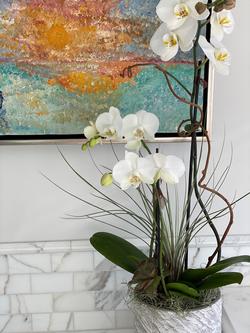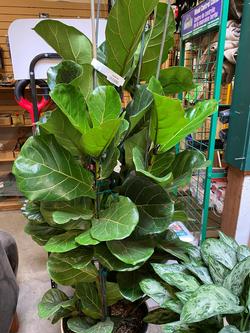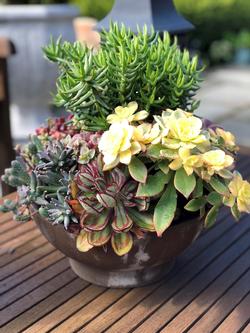Tending your indoor garden
-
Dot Zanotti Ingels
-
 This combination of Phalaenopsis orchi, succulents and tillandsia does well in indirect bright light, watering as the plants approach dryness.
This combination of Phalaenopsis orchi, succulents and tillandsia does well in indirect bright light, watering as the plants approach dryness.
We are definitely spending more time inside at this time of year, but we can create an indoor garden with ease with a bit more knowledge of how to make the plants feel at home. Our homes are generally not the perfect place to meet the needs of plants. Unlike the nursery, we may not have the ideal light intensity, consistent temperature and controlled watering and feeding. Our challenge is to choose plants that can withstand our indoor conditions of a chosen location and to learn how to care for them properly.What to choose? Just like outdoors, the mantra is right plant in the right place. The environmental factors that encourage proper indoor plant growth and health are interrelated. Choose plants that are sturdy, clean, free of insects and diseases, nicely shaped and well covered in leaves. Plants that have good color, leaf buds and young growth are usually a good bet. Here are some key points to consider:
- Soil. Potting media used for houseplants is often largely organic. Many plants will become root-bound and will go from too wet to too dry quickly which is very stressful to any plant. Salt levels can also build up in the pots. Salts can be leached from the soil by periodically letting the plants soak.
 Ficus lyrata, Fiddle Leaf Fig, is an investment plant requiring a warm, humid environment away from drafts and plenty of ambient light.
Ficus lyrata, Fiddle Leaf Fig, is an investment plant requiring a warm, humid environment away from drafts and plenty of ambient light. - Light. Light is probably the most essential elements but is often the most elusive to figure out. Light intensity, the brightness of the light, influences the synthesis of plant food, stem length, leaf color and flowering. The intensity of the indoor light a plant receives is dependent on proximity of the light source to the plant, the placement of windows in your home and any other factors that enhance or inhibit the light coming into the room. Houseplants are classified by their general light requirements. Low light conditions are more than six feet from windows and receive no direct light. Medium light areas are three to six feet from windows. High-light areas are within three feet. Remember that seasons are almost reversed for plants inside your home. The summer sun is high overhead much of the day and many plants see little or direct light indoors. Conversely, in winter, the sun is lower and can shine through the windows for longer periods of time. You may need to move your plants seasonally or otherwise offer them protection.
- Water. Overwatering or underwatering causes most of the problems with indoor plants. There is no easy answer to how much or how little to water your plants, but it is important not to let the soil medium dry out completely between watering. Never allow plants to stand in water. Water until a little water runs out the bottom of the pot to make sure all the soil gets sufficient water and then, empty the saucer.
 Succulents can thrive indoors if planted in a cactus mix with excellent drainage and watered only after drying out. Placed in an area with bright ligh
Succulents can thrive indoors if planted in a cactus mix with excellent drainage and watered only after drying out. Placed in an area with bright ligh - Humidity. Some indoor plants do best with a higher percentage of moisture in the air. This can easily be achieved by placing gravel trays under the plant or by misting.
- Ventilation. Many houseplants are very sensitive to cold drafts or heat from forced air registers. Keep them away from any rapid fluctuations in their environment.
- Fertilization. Houseplants need fertilizers that contain the three major plant nutrients: nitrogen (N), phosphorous (P), and potassium (K). Fertilizers for houseplants come in many forms. It is essential that fertilizer be used according to the instructions on the package label.
- Pests. The most common houseplant insects and mite pests are aphids, spider mites, mealy bugs, scales, whitefly and thrips. The treatment for these invaders depends on the pest and the plant.
- Diseases. Houseplant diseases include fungi, bacterial diseases, powdery mildew, water mold rots and fungal leaf spots and blights.
For complete information on what causes your houseplant problems, how to diagnose them and how to treat them, go to http://ipm.ucanr.edu/ and click on the link to Home, Garden, Turf and Landscape Pests.



